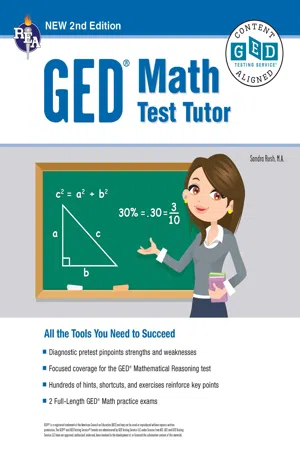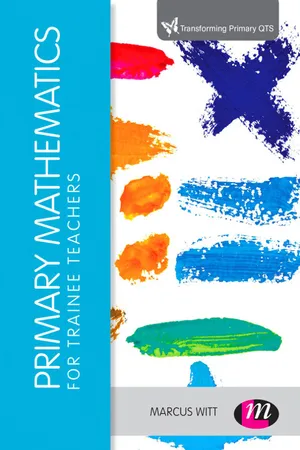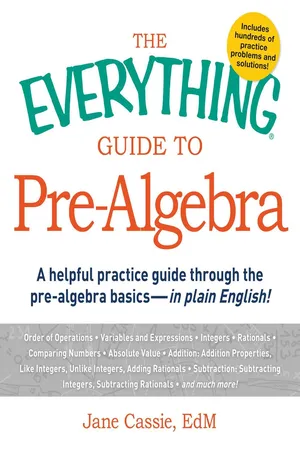Mathematics
Simplifying Fractions
Simplifying fractions involves reducing a fraction to its simplest form by dividing the numerator and denominator by their greatest common divisor. This process ensures that the fraction is expressed in its most compact and easily understandable form. By simplifying fractions, it becomes easier to compare and perform operations with different fractions.
Written by Perlego with AI-assistance
Related key terms
7 Key excerpts on "Simplifying Fractions"
- eBook - ePub
- Sandra Rush(Author)
- 2017(Publication Date)
- Research & Education Association(Publisher)
multiplication of fractions is easier, so we will start with that. Division of fractions is just like multiplication, so if you understand multiplication of fractions, you also understand division.Generally, when you multiply two or more fractions, you multiply the numerators to get the numerator of the answer, and then you multiply the denominators to get the denominator of the answer. For example, . However, three facts that we already know make this calculation easier:1.Any number divided by itself equals 1, or, for example, .2.Any number multiplied by 1 is unchanged, so 4 × 1 = 4.3.The value of 3 × 4 is the same as 4 × 3 (the commutative property of multiplication).If we multiply the above fractions out, , we get as a final answer . But let’s switch some of the numbers around. We already know that it won’t affect the value of the final fraction. So let’s get the equivalent by switching the 5 × 4 and the 7 × 8 in the denominator to 4 × 5 and 8 × 7. Since and , this is the same as , or just , much easier to work with than . This is called cancellation—we can cancel the same factors in the numerator and denominator of a fraction.But there is even more to cancellation. Can the fraction be reduced even further? Yes, if we write it as , we can cancel the 2’s and get , which is the fraction in lowest terms. Lowest terms means it cannot be reduced any further. There are no numbers that divide evenly into both 9 and 20. This is also called simplifying the fraction.A lot of cancellation can be done in your head by using your knowledge of the multiplication tables. For example, can be rewritten as by recognizing a common factor of 12 and canceling it from the top and bottom of the fraction. That’s the important part of cancellation—the number must be a factor in the numerator and the denominator, and you can cancel it only once.Now let’s say we didn’t recognize 12 as a common factor but instead knew that 6 was a common factor. We would get . Then, since these are both even numbers, we should see that 2 is also a common factor, and we get - eBook - ePub
- Marcus Witt(Author)
- 2014(Publication Date)
- Learning Matters(Publisher)
When we multiply any number by 1 the answer remains the same because 1 does not change it in any way. The same is true when we multiply a fraction by 1 and that is exactly what we are doing in the equation above: 5/5 = 1. So although the numerator and denominator change, the fraction itself is equivalent to the fraction we started with.Simplifying Fractions
When a solution is found, it can be represented in a simpler way. For example, if the solution was 4/10 we could simplify this to make 2/5 by finding the common factor (in this case, 2).Activity: Comparing and Ordering Fractions
A group of children were asked to place unit fractions on the number line in order. This is what they produced: What errors have the children made?A common error children make when comparing and ordering fractions is related to thinking about the denominator as a whole number in its own right. In the children's work above, they have correctly placed ½ (from prior experience, knowing ½ is in the middle of 0 and 1 on the number line), but they were unsure about placing the other fractions. They have focused on the denominators and ordered them as if they were whole numbers.It is important for children to understand that the larger the denominator the more parts the whole has been equally divided into so the parts are smaller. Children intuitively understand this principle in practical situations, so you could include sharing in role-play situations or play games. For example, you could provide two tables (red tablecloth and blue tablecloth), each with the same desirable item on them (for example, a cake, pie or apple). Place four chairs around the red table and six chairs around the blue and ask the children which table they would prefer to sit at. Giving them a red card and blue card to hold up will involve everyone. Agree the fraction of the item the children would receive at each table (in this case ¼ and 1/6) and compare the fractions with the parts of the item. Change the number of chairs and the type of items (you may even want to place undesirable items) to reinforce for children that the larger the denominator the smaller the parts become and vice versa. - eBook - ePub
- Edward Stoddard(Author)
- 2013(Publication Date)
- Dover Publications(Publisher)
18MASTERING FRACTIONSO F ALL the specialized branches of mathematics, fractions seem to be greeted with more general panic than all the others put together.It does not have to be so. Fractions are really not much more complicated than multiplying or dividing. Perhaps the reason for their general unpopularity is that they are taught, to an even greater extent than is true for the other processes, almost entirely by rote. The rote itself simply has to have a few more steps and rules than do whole numbers.You can add any two whole numbers together without doing anything to them first. But not fractions. The reason why this is so has apparently escaped the normal teaching methods. Many people have trouble understanding why you can multiply two fractions together and get an answer smaller than either of them. If you multiply two numbers together, isn't the answer larger than either? Again—not with fractions.Both peculiarities, along with the other peculiarities, are inherent in the true nature of fractions. Let us approach their nature with some general observations.A fraction is, in essence, a number that cannot be expressed normally in our decimal system of digits running from 1 to 9 and then starting over. It is usually smaller than 1, and our counting system has no way of expressing such a quantity other than the apparently awkward form of the fraction (other than a decimal, which is merely a fraction written in another way).A fraction, even if we have no other way to indicate it than a fraction, is however a very real number or quantity. The form in which we show it is really a fabulously ingenious and useful method of expressing any conceivable quantity from any conceivable counting base in terms of the number system we know.Imagine, if you will, that our base quantity “1” is a loaf of bread. We have built up a complete arithmetic based on loaves of bread; we have units of ten loaves; we have learned by heart how to add 3 loaves to 6 loaves, to start with 8 loaves and take away 4 loaves, to imagine that one group of 2 loaves has been doubled, or multiplied by 2. But then, suddenly, one of our loaves breaks into pieces and we must account for the pieces. - eBook - ePub
The Everything Guide to Pre-Algebra
A Helpful Practice Guide Through the Pre-Algebra Basics - in Plain English!
- Jane Cassie(Author)
- 2013(Publication Date)
- Everything(Publisher)
Chapter 5 FractionsBy clarifying the rules and process for how you write, alter, and manipulate fractions, you’ll be getting ready to start adding variables into your math problems. The most important part of pre-algebra is clarifying the rules that you already know how to follow, so that you can still follow the rules when the numbers start getting replaced with variables. Fractions won’t just show up by themselves anymore—they’ll be mixed into math problems that test all different kinds of material.Introduction to Fractions
There are three big ways that mathematicians represent non-integer numbers: decimals, fractions, and percentages. Let’s say you have one orange, and you put a knife right in the middle and slice. You take a piece, and your friend takes a piece. You could say, “I have half of the orange.” Or, your friend could say, “I have 50 percent of the orange.” Or, you could say, “I have .5 oranges.” All of these sentences mean the same thing.Fractions are pretty much everyone’s least favorite part of math, but they don’t have to be. The key is to take the time to understand what they mean instead of just trying to memorize the rules you are supposed to follow. Once you understand why the rules are what they are, they are much easier to remember.Numerator and Denominator
A fraction is just one number on top of another number. The top number is called the numerator , and the bottom number is called the denominator . These words are specific to fractions—they don’t mean anything except “top number” and “bottom number.”The bottom number tells you how many pieces of something make up the whole. For example, when you cut that orange in half, there are two pieces, so the denominator would be 2. The top number tells you how many pieces you have. In the same example, the numerator would be 1, because you only have one piece of the orange. - eBook - ePub
- W. W. Sawyer(Author)
- 2012(Publication Date)
- Dover Publications(Publisher)
d by these numbers, the algebra should turn back into a sensible piece of arithmetic.All the methods given in this chapter for the arithmetic of fractions can be translated into algebra.For example, we can divide by using the following method:If we use the code above, this becomes:You may ask, ‘Why did we not go on to simplify and express it as The reason is that this cancelling was due to an accident in our original choice of numbers 2, 3, 4, 5. The numbers 2 and 4 are closely related. If we had chosen 2, 3, 5, and 7 for a , b , c , d , no cancelling would occur. This is a point that always has to be watched in algebra; to make sure that your argument applies for any numbers whatever, and that you have not been misled by some accidental feature of a particular case.It may be noticed that this last result amounts to a statement of the ‘invert and multiply’ rule for division of fractions. We set out to divide a /b by c /d . Our answer is the same as we should have found if we had set out to multiply a /b by d /c .How far this algebraic argument should be used in the teaching of elementary arithmetic is a matter for the judgement of the teacher. The deciding principle is one that applies to every use of algebra in arithmetic lessons. Algebra may be used as a shorthand provided the pupil is perfectly happy with this shorthand, and can use algebra confidently as a way of recording facts about arithmetic which he already understands. If a pupil is not clear about algebra, it will only increase his mystification if we try to teach him arithmetic through algebra.FRACTIONS AND WHOLE NUMBERS
When a think-of-a-number trick is shown to a class of children, the numbers thought of are usually fairly small ones. When the trick has been found to work for all of these, some child may raise the question, ‘Would the trick still work if I thought of a big number like 253?’ It is found that the trick does work. Then some child may ask, ‘Would it work for a fraction? What would happen if I thought of - eBook - ePub
Fostering Children's Mathematical Power
An Investigative Approach To K-8 Mathematics Instruction
- Arthur Baroody, Arthur J. Baroody, Ronald T. Coslick(Authors)
- 1998(Publication Date)
- Routledge(Publisher)
, children must discover that the denominator of the sum is derived from multiplying the denominators of the addends, not adding them.In Unit 10•1, we illustrate how learning a variety of meanings for an arithmetic operation (see chapter 5 ) is crucial for comprehending operations on fractions, in general, and fraction multiplication and division, in particular. In Unit 10•2, we illustrate how to help children understand operations on common fractions. This understanding will make their task of understanding operations on decimals (addressed in chapter 11 ) considerably easier.What the NCTMStandards SayGrades K-4 “In grades K-4, the mathematics curriculum should include fractions so that students can:◆ use models to explore operations on fractions … ;◆ apply fractions … to problem situations” (NCTM, 1989, p. 57).Grades 5–8 “In grades 5–8, [instruction] should develop the concepts underlying computation and estimation in various contexts so that students can:◆ compute with…fractions…and rational numbers;◆ develop, analyze, and explain procedures for computation and .. . estimation;◆ use computation [and] estimation [procedures] to solve problems;◆ use estimation to check the reasonableness of results” (NCTM, 1989, p. 94).10•1 Mathematics and LearningIn Subunit 10•1•1, we outline meaningful analogies for operations on fractions. In Subunit 10•1•2, we explore children’s thinking for clues about where to begin instruction on fraction arithmetic and why it is often so onerous (see Figure 10.1 - eBook - ePub
Knowing and Teaching Elementary Mathematics
Teachers' Understanding of Fundamental Mathematics in China and the United States
- Liping Ma(Author)
- 2020(Publication Date)
- Routledge(Publisher)
3 Generating Representations: Division By FractionsScenario
People seem to have different approaches to solving problems involving division with fractions. How do you solve a problem like this one?13 4÷1 2=Imagine that you are teaching division with fractions. To make this meaningful for kids, something that many teachers try to do is relate mathematics to other things. Sometimes they try to come up with real-world situations or story-problems to show the application of some particular piece of content. What would you say would be a good story or model for?13 4÷1 2=This time the teachers are required to accomplish two tasks: to compute, and to represent meaning for the resulting mathematical sentence. The mathematical topics discussed in the previous two chapters are relatively elementary, but division by fractions is an advanced topic in arithmetic. Division is the most complicated of the four operations. Fractions are often considered the most complex numbers in elementary school mathematics. Division by fractions, the most complicated operation with the most complex numbers, can be considered as a topic at the summit of arithmetic.13 4÷1 2The U.S. Teachers’ Performance on Calculation
The weaknesses of the U.S. teachers’ subject matter knowledge were more noticeable in this advanced topic than in the two topics discussed earlier. Their discussions of whole number subtraction and multiplication had all displayed correct procedural knowledge, but even this was lacking in many of their discussions of division by fractions. Of the 23 U.S. teachers, 21 tried to calculate. Only nine (43%) completed their computations and reached the correct answer. For example, Mr. Felix, a beginning teacher, gave this explanation:13 4÷1 2I would convert theto fourths, which would give me13 4. Then to divide by7 4, I would invert1 2and multiply. So, I would multiply1 2by 2 and I would get7 4, and then I would divide 14 by 4 to get it back to my mixed number,14 4or then I would reduce that into32 431 2.
Learn about this page
Index pages curate the most relevant extracts from our library of academic textbooks. They’ve been created using an in-house natural language model (NLM), each adding context and meaning to key research topics.






